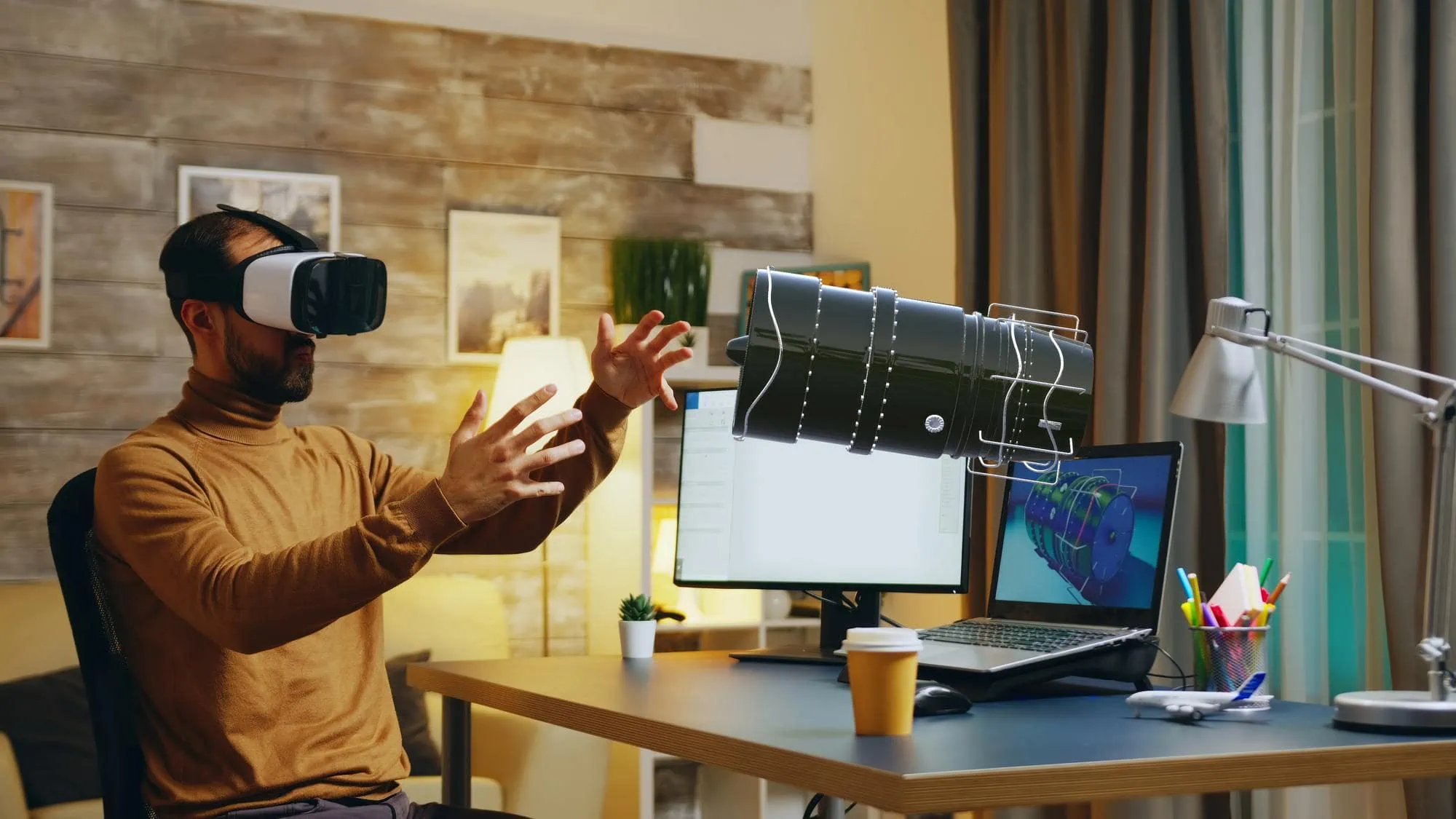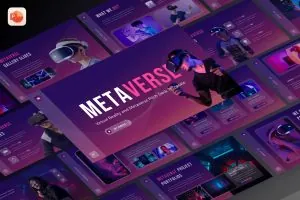Metaverse Designing: Introduction
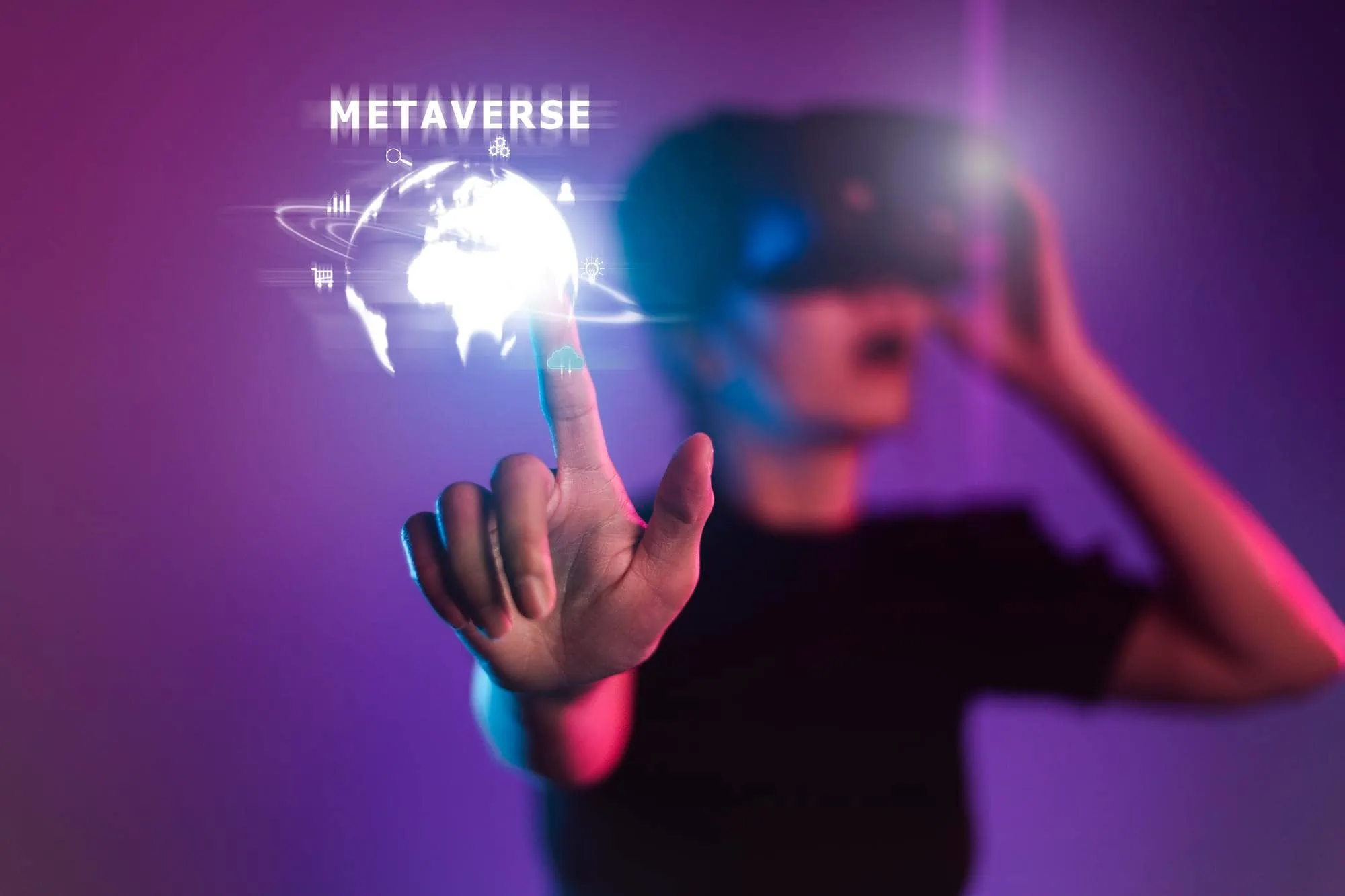
The fusion of the digital and physical realms, the ever-expanding ecosystem of interconnected virtual worlds, and the next step in the evolution of the internet: this is the metaverse.
As we stand on the brink of this new era, it’s imperative to understand its implications, especially in the world of design.
Definition of the Metaverse
The metaverse is a collective virtual shared space created by converging virtually enhanced physical reality and interactive digital spaces.
It is often described as a successor to the internet. It takes the form of interconnected 3D virtual worlds where users can interact with the environment, digital objects, and other users, usually through avatars.
This space is persistent, meaning it continues to exist and evolve even when individual users log off.
Brief Overview of its Rise in Popularity
The metaverse concept has its roots in science fiction, most notably from Neal Stephenson’s 1992 novel “Snow Crash” and Ernest Cline’s 2011 “Ready Player One.”
However, the recent surge in its popularity can be attributed to a confluence of factors:
- Technological Advancements: The rapid growth in VR and AR technology, high-speed internet, and more powerful computing capabilities have made the idea of a fully immersive digital universe more feasible than ever before.
- Cultural Shifts: The boundaries between our online and offline identities have been blurring. People are increasingly living a significant portion of their lives online through social media, online gaming, or digital workspaces.
- Business Interest: Big tech companies like Facebook (now Meta), Google, and Microsoft have shown keen interest in the metaverse, investing billions into its development. Their backing brings not just capital but also legitimizes the metaverse’s importance in the future of digital interaction.
- Covid-19 Pandemic: The global pandemic accelerated digital adoption across various sectors. Virtual meetings, events, and conferences became the norm, further priming society for immersive digital experiences.
The metaverse is not just a buzzword; it signifies a shift in how we perceive, interact, and live within the digital realm.
As designers and creators, understanding this space is crucial to remain relevant and shape the very fabric of this burgeoning universe.
Understanding the Metaverse Canvas
As the metaverse expands, so does the complexity and depth of the canvas on which designers and developers work.
Unlike the traditional 2D interfaces of web and mobile applications, the metaverse requires a deep understanding of multi-dimensional, immersive spaces.
3D Digital Spaces
Designing for the metaverse is a leap into the vastness of 3D digital spaces, demanding a paradigm shift in design thinking and techniques.
The Departure from Flat Designs
Traditionally, graphic designers worked mainly on a 2D plane. Even when crafting designs that gave the illusion of depth, they were still bounded by the constraints of flat screens.
With the metaverse, this has changed dramatically.
Designers now need to think volumetrically, understanding depth, perspective, and spatial relationships in a much more intricate manner.
This means objects aren’t just placed side by side but can be above, below, behind, or in front of each other, creating a more decadent layer of interaction and immersion.
Immersive Environments: More than Just Visuals
In the metaverse, environments are not merely backdrops but essential parts of the experience.
An environment can influence mood, guide user behavior, or even become a central element of a narrative. The lighting, weather, and even the simulated physics can play pivotal roles.
For instance, an underwater environment might have muted sounds, distorted vision, and a feeling of weightlessness—all elements that designers need to consider.
The Importance of Audio, Spatial Relationships, and Interactivity
Visuals are just one part of the design puzzle in the metaverse. Sound becomes an equally crucial aspect.
It helps in creating an atmosphere, directing attention, or offering feedback.
Spatial audio, where the sound’s direction and intensity change based on user positioning, enhances realism. Spatial relationships are fundamental in navigating these 3D spaces.
Understanding how objects relate to each other in space, ensuring a logical flow, and maintaining proportions become key.
Interactivity is at the heart of the metaverse. Everything can interact with, whether it’s picking up an object, pushing a button, or conversing with an AI-powered character. Designers need to ensure these interactions feel natural and intuitive.
Virtual Reality (VR) and Augmented Reality (AR) Platforms
As gateways to the metaverse, VR and AR platforms provide unique opportunities and challenges that influence design.
How These Platforms Influence Design Decisions
VR offers a fully immersive experience, enveloping users in a digital environment.
Design for VR demands a 360-degree perspective, ensuring that the user’s experience is consistent and engaging in all directions.
Motion and depth perception become critical, as does providing user comfort to prevent motion sickness.
AR, on the other hand, overlays digital elements in the real world.
This requires designs to be more context-aware, understanding the physical environment, and ensuring digital additions feel organic and not jarring.
Realism Versus Stylization in Design
One of the pivotal decisions designers face is choosing between realistic and stylized designs.
With VR’s immersive nature, there’s often a push for hyper-realistic designs to enhance the feeling of “presence.”
However, too much realism can lead to the “uncanny valley,” where something looks almost real but just off enough to be unsettling.
AR often leans towards stylization, as the juxtaposition of real and digital can be embraced as a feature rather than a challenge. Stylized designs can also be less resource-intensive, allowing for smoother performance.
Understanding the metaverse canvas requires designers to break free from traditional 2D confines, embracing the depth and complexity of 3D spaces and the unique considerations of VR and AR platforms.
Key Graphic Trends in the Metaverse

With its expansive and immersive landscape, the metaverse has led to several groundbreaking graphic trends.
These trends not only define the current visual appeal of virtual spaces but also chart the course for future innovations in the domain.
Hyper-realistic Textures and Environments
The push for realism in the metaverse is unrelenting, taking users as close to reality as technologically possible.
Going Beyond Traditional 3D
Modern rendering techniques are moving beyond the basics of 3D modeling. Advanced shaders, ray tracing, and detailed texture maps offer skin, fabric, and surfaces that look and feel incredibly real. The grains of wood, the flow of water, or the wrinkles on a character’s face are all rendered with meticulous detail.
The Nuances of Light, Shadow, and Reflection
Light is an essential tool for designers in the metaverse. Real-time ray tracing allows light to bounce off objects, cast realistic shadows, and create reflections just as in the real world. These subtle details, like the soft glow of sunlight filtering through leaves or the reflection on a glass building, contribute immensely to the immersion.
Fluid and Dynamic Interfaces
The metaverse interfaces are evolving to be more fluid, adapting to user needs and preferences in real-time.
Adaptive Designs for User Experiences
Instead of fixed interfaces, we see designs that adapt based on user behavior, context, or even mood. If a user frequently accesses a particular tool or feature, the interface might be rearranged to make that feature more accessible.
Moving from Static to Motion Interfaces
Motion design is at the forefront, with elements that move, shift, and evolve, making interfaces feel alive. This dynamism captures attention, guides the user’s eye, and can also be functional, signifying changes or updates.
Personalized and Customizable Avatars
Avatars are the digital representatives of users in the metaverse, and their design is witnessing incredible innovation.
Evolution of Avatar Designs
From rudimentary figures to complex, detailed personas, avatars have evolved significantly. Today’s avatars can mimic facial expressions, move with lifelike fluidity, and even age.
Balancing Realism with Expressiveness
While there’s a push for realistic avatars, there’s also a parallel trend for highly stylized and expressive avatars. This balance allows users to represent themselves in diverse ways, from accurate reflections of their real selves to fantastical versions or entirely imagined entities.
Integration of Real-world and Digital Artifacts
Bridging the tangible with the intangible, this trend is about seamlessly merging the physical and digital worlds.
Merging Tangible and Intangible Elements
Digital artifacts, whether they’re collectible items, artworks, or tools, are being designed with a tactile feel. There’s an emphasis on making digital items “feel” real, even if they can’t be touched in a physical sense.
The Role of AR in Layering Digital Content onto the Physical World
Augmented reality plays a pivotal role in this integration. Whether it’s overlaying digital art on a real wall or placing a virtual product in a physical room, AR blurs the lines between what’s real and what’s digital, creating hybrid experiences.
Interactivity and User Agency
The metaverse is a space for users to interact, explore, and even shape their narratives.
Designs that Respond and Adapt
Gone are the days of static designs. Today, elements in the metaverse respond to users. Trees might sway as you walk past them, or a character might greet you as you approach.
Facilitating User-driven Storylines and Narratives
Users aren’t just passive consumers in the metaverse; they’re active participants. Designs are facilitating more user agency, allowing them to shape events, create content, and even change the course of stories.
The metaverse’s graphic trends push boundaries, redefine immersion, and place the user at the center of ever-evolving digital experiences.
Challenges in Designing for the Metaverse
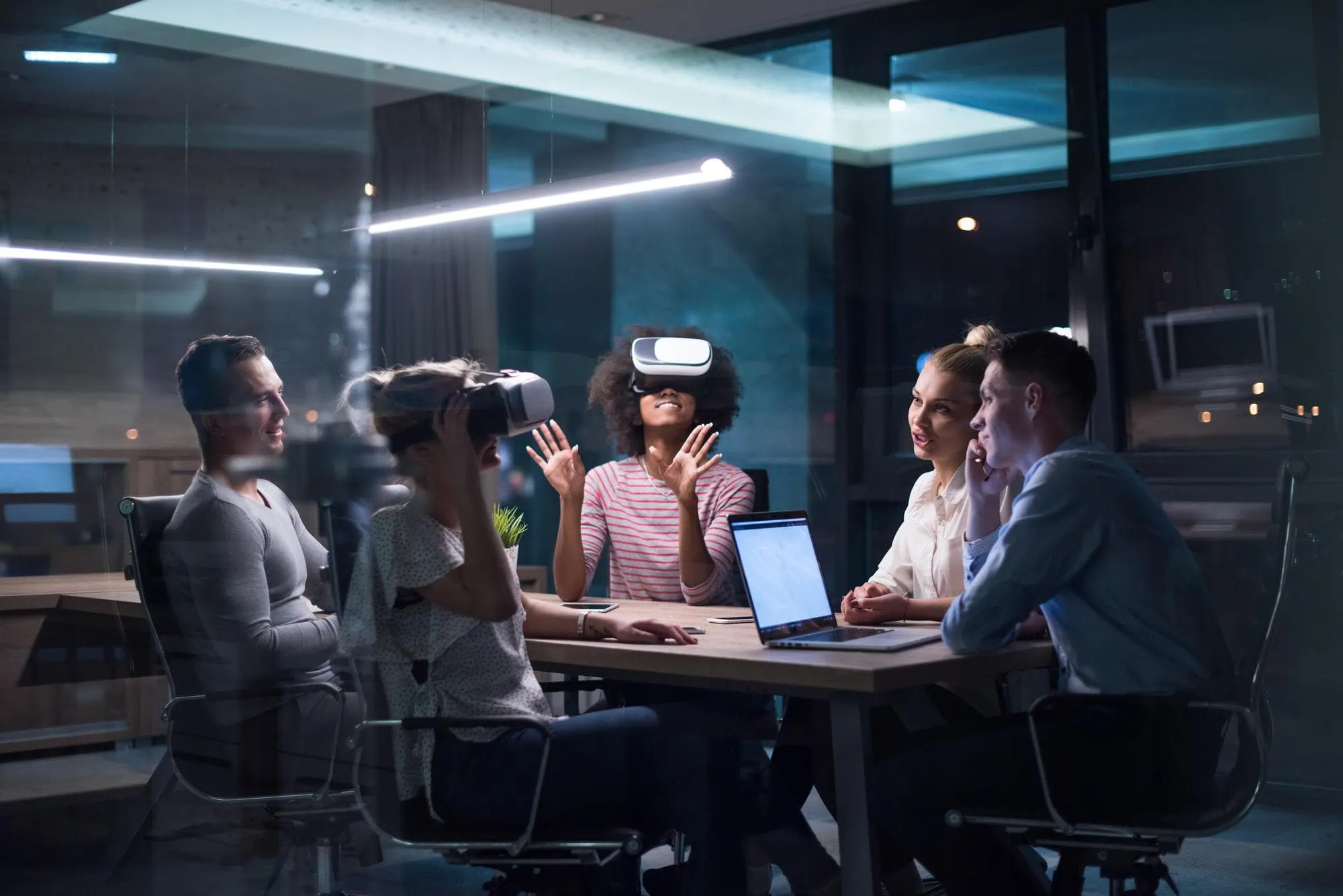
Designing for the vast and intricate landscape of the metaverse brings forth a new set of challenges.
As designers and developers chart this unexplored territory, they must address these hurdles to create an inclusive, ethical, and user-friendly metaverse.
Ensuring Accessibility
The metaverse should be a place for everyone, regardless of physical or cognitive abilities.
Design Considerations for Users with Disabilities
Designers must ensure that their creations are accessible to users with various disabilities.
This includes considering visual impairments (by offering adjustable lighting or high-contrast modes), auditory impairments (through subtitles or visual cues for sounds), and mobility challenges (with easy-to-use navigation tools or voice commands).
Making the Metaverse Inclusive for Everyone
Beyond just disabilities, the metaverse should be welcoming to all, regardless of age, language, or cultural background.
This includes offering multilingual support, culturally diverse environments, and user interfaces that can be intuitively used by people from various backgrounds.
Navigating Ethical Considerations
The immersive nature of the metaverse presents unique ethical challenges.
Potential for Deepfakes and Misinformation
The advanced graphics capabilities in the metaverse can be misused to create deceptive content or “deepfakes.”
These could be used to spread misinformation or mislead users in various ways.
Designers and platform creators must find ways to verify and authenticate content.
Respecting Privacy and Personal Boundaries
With more personal interactions and potentially more data being shared in the metaverse, there’s a heightened need to respect user privacy.
Designers need to ensure that private spaces are not invaded and that users have control over what information they share.
Hardware Limitations
The varying capabilities of user hardware present challenges for universal design.
Designing for a Range of Devices and Specifications
Users might access the metaverse through high-end VR headsets, budget AR glasses, or even just their PCs and smartphones.
Designs need to be adaptable to offer a consistent experience across devices with vastly different capabilities.
The Balance Between Quality and Performance
While hyper-realistic graphics and intricate designs are appealing, they demand high computational power.
The metaverse designers must strike a balance, ensuring that their creations are stunning but also run smoothly on various devices.
Continuous Evolution and Updates
The metaverse is in a state of constant flux, with new technologies emerging regularly.
Keeping Up with Rapid Technological Changes
The metaverse designers must be agile, ready to adapt and evolve their designs with the latest technologies, new rendering techniques, AI integrations, or novel interaction methods.
Ensuring Designs are Future-Proofed
While adaptation is necessary, designers should also aim to create relevant and functional designs for a more extended period, even as the metaverse grows and changes.
Cognitive Overload and User Fatigue
With so much happening in the metaverse, there’s a risk of overwhelming users!
Being Mindful of Overwhelming Users
The richness and depth of the metaverse can be a double-edged sword. Too much happening at once can confuse or overwhelm users.
While designing metaverse, the designers need to be judicious in how much they present at any given moment.
Simplifying Without Sacrificing Depth
The challenge lies in creating interfaces and environments that are simple and intuitive on the surface but can reveal deeper layers as users choose to dive in.
This ensures that both newcomers and seasoned metaverse explorers have satisfying experiences.
While the potential of the metaverse is vast, so are the challenges that come with designing for it.
By addressing these challenges head-on, designers can shape an inclusive, ethical, user-friendly, and future-ready metaverse.
Best Practices for Metaverse Designing
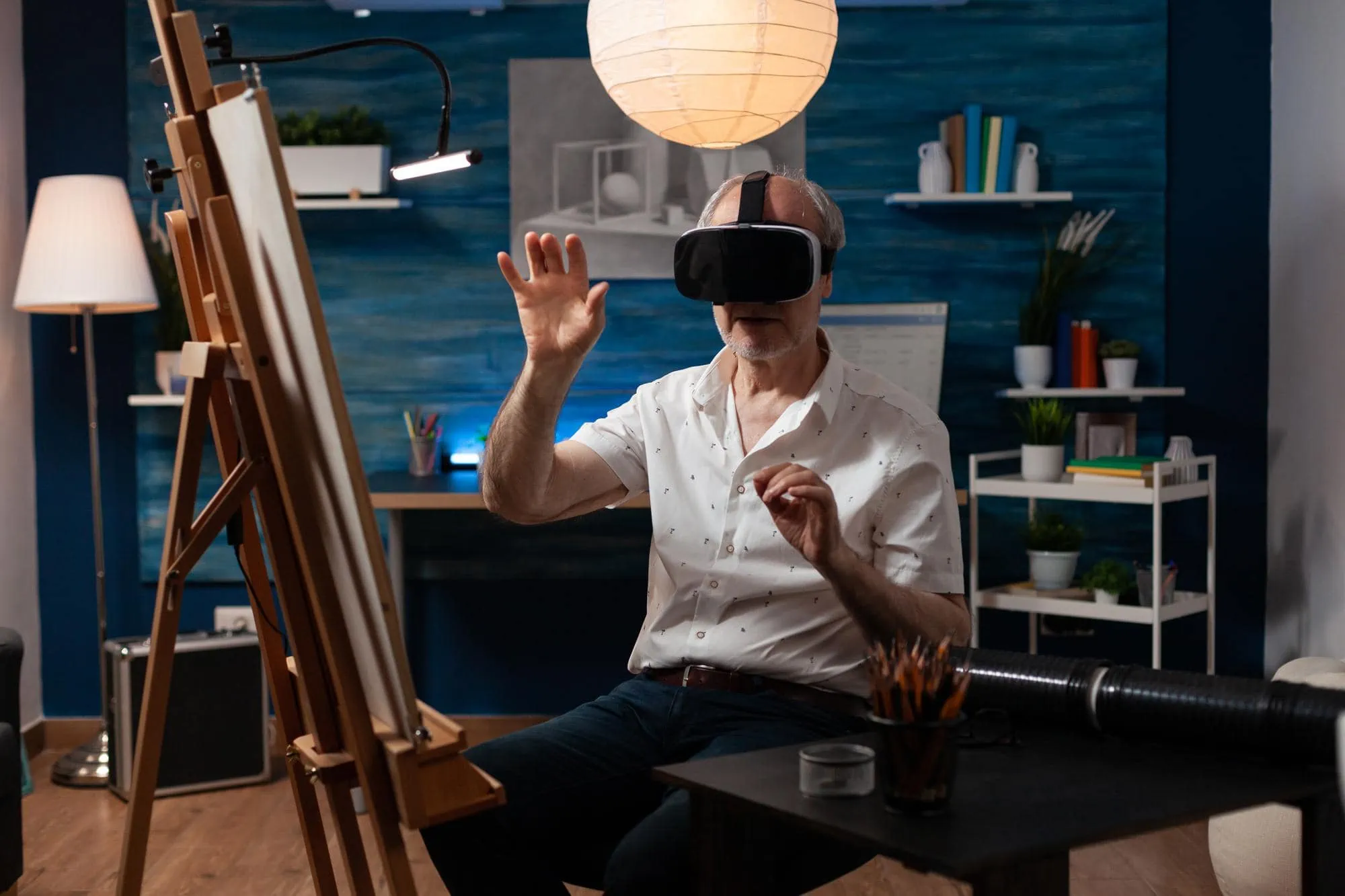
Metaverse designing requires a blend of creativity, technology, and a keen understanding of the user.
Here are some best practices that can guide designers as they navigate this complex and dynamic virtual universe.
Prioritize User-Centered Design
In the vastness of the metaverse, keeping the user at the forefront is paramount.
Understanding and Catering to User Needs
Every design decision should stem from a deep understanding of the user’s needs, desires, and behaviors.
This involves conducting user research, building user personas, and using these insights to shape the design.
For instance, if a large segment of your target audience is new to virtual environments, intuitive navigation and onboarding become crucial.
Continuous Testing and Feedback Loops
The metaverse is a novel domain, and user behavior assumptions might not always be true.
Continuous user testing through alpha and beta testing or focus groups can provide valuable insights.
Gathering feedback, analyzing it, and iterating based on this feedback ensures that the designs remain relevant and user-friendly.
Embrace Interdisciplinary Collaboration
The metaverse isn’t just about visuals; it’s an amalgamation of various design disciplines coming together.
Merging Skills from Graphic Design, UX, Sound Design, and More
A truly immersive metaverse experience is multi-faceted. It involves stunning visuals, intuitive interfaces, spatial audio, engaging narratives, and more. This necessitates collaboration between professionals from various domains – graphic designers, UX/UI experts, sound engineers, narrative designers, and even AI specialists.
The Importance of Diverse Teams for Diverse Experiences
The metaverse is a space for everyone, and its design should reflect the diversity of its users.
Assembling a diverse design team ensures that various perspectives, backgrounds, and experiences are considered.
This leads to a richer, more inclusive metaverse that caters to a broad spectrum of users.
Stay Updated with Emerging Technologies
The metaverse is ever-evolving, with new technologies and tools continuously shaping its landscape.
Continuous Learning and Upskilling
The graphic designers cannot afford to be complacent. Staying updated with the latest technologies, techniques, and design philosophies is essential.
This might involve taking courses, attending workshops, or simply staying engaged with the design and tech communities.
Leveraging New Tools and Platforms for Better Designs
As new tools and platforms emerge, they bring with them novel capabilities. Designers should be quick to adopt and leverage these tools.
Whether it’s a new rendering software that offers more realistic lighting or an AI tool that enables more imaginative interactivity, these tools can significantly enhance the quality and depth of metaverse designs.
Designing for the metaverse is an intricate endeavor that demands a user-centric approach, interdisciplinary collaboration, and a commitment to continuous learning.
By adhering to these best practices, designers can craft immersive, engaging, and inclusive experiences that truly define the essence of the metaverse.
Best Examples of The Metaverse Projects
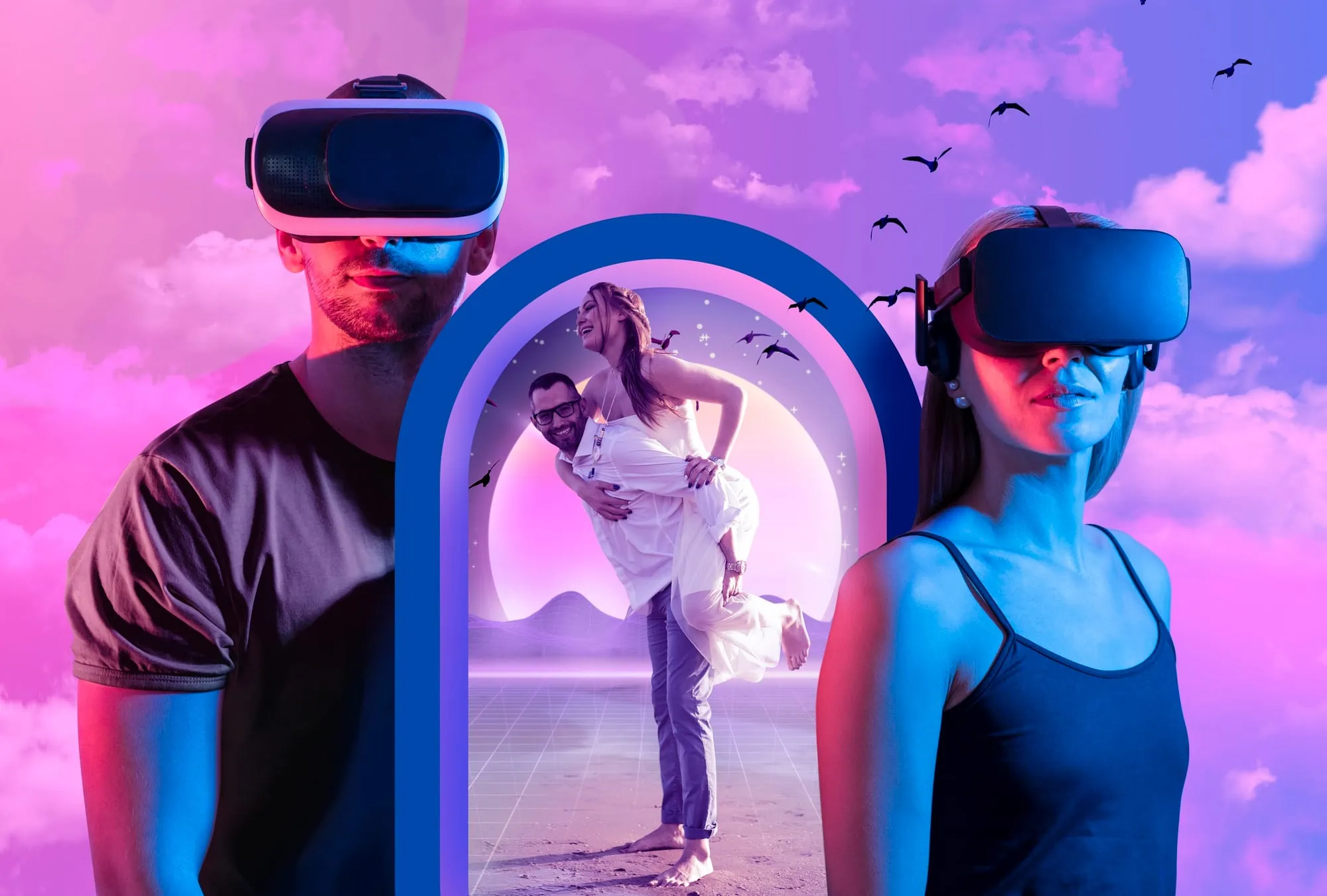
There are several metaverse projects and platforms have gained significant attention and success. Here are some of them:
- Fortnite by Epic Games: While initially launched as a battle royale game, Fortnite has evolved into a more expansive platform, hosting virtual concerts, movie previews, and other social experiences that hint at metaverse-like functionalities. Events such as the Travis Scott concert attracted millions of simultaneous players, showcasing the potential of virtual shared experiences.
- Roblox: Roblox is more than just a game; it’s a platform where users can create and share their own game worlds. It represents a kind of user-generated metaverse where players can jump from one experience to another. With its virtual economy, in-game events, and vast user-created worlds, it’s a prime example of a budding metaverse.
- Decentraland: A decentralized virtual world where players can purchase, develop, and sell parcels of land. Decentraland operates on the Ethereum blockchain, allowing users to have true ownership of their virtual land and the assets they create or acquire within this world.
- VRChat: A virtual reality social platform that allows users to create and explore virtual worlds, attend events, and interact with other users using customizable avatars. It has gained popularity for its open-ended experience and the diversity of user-generated content.
- The Sandbox: A virtual world that allows users to own, create, and monetize their gaming experiences using the Ethereum blockchain. The Sandbox provides tools for players to design and animate their in-game assets, leading to a metaverse built on user-generated content.
- CryptoVoxels: Another blockchain-based virtual world where users can buy, develop, and sell parcels of virtual land. It’s simpler in design compared to some other platforms but has attracted a niche community and various artists and developers.
- NeosVR: A metaverse engine and platform that is built around social experiences. It allows users to create, share, and experience content in virtual reality, pushing the boundaries of what’s possible in VR-based shared spaces.
- Somnium Space: A continuously evolving VR world where users can buy land, build, design, and monetize. It also incorporates blockchain technology for true ownership of digital assets.
These projects and platforms, among others, have paved the way for the evolution of the metaverse concept, highlighting different possibilities and paths towards a shared virtual future.
As technology progresses, it’s expected that the definition and scope of the metaverse will further expand with even more immersive and interconnected experiences.
The Metaverse Designing: Conclusion
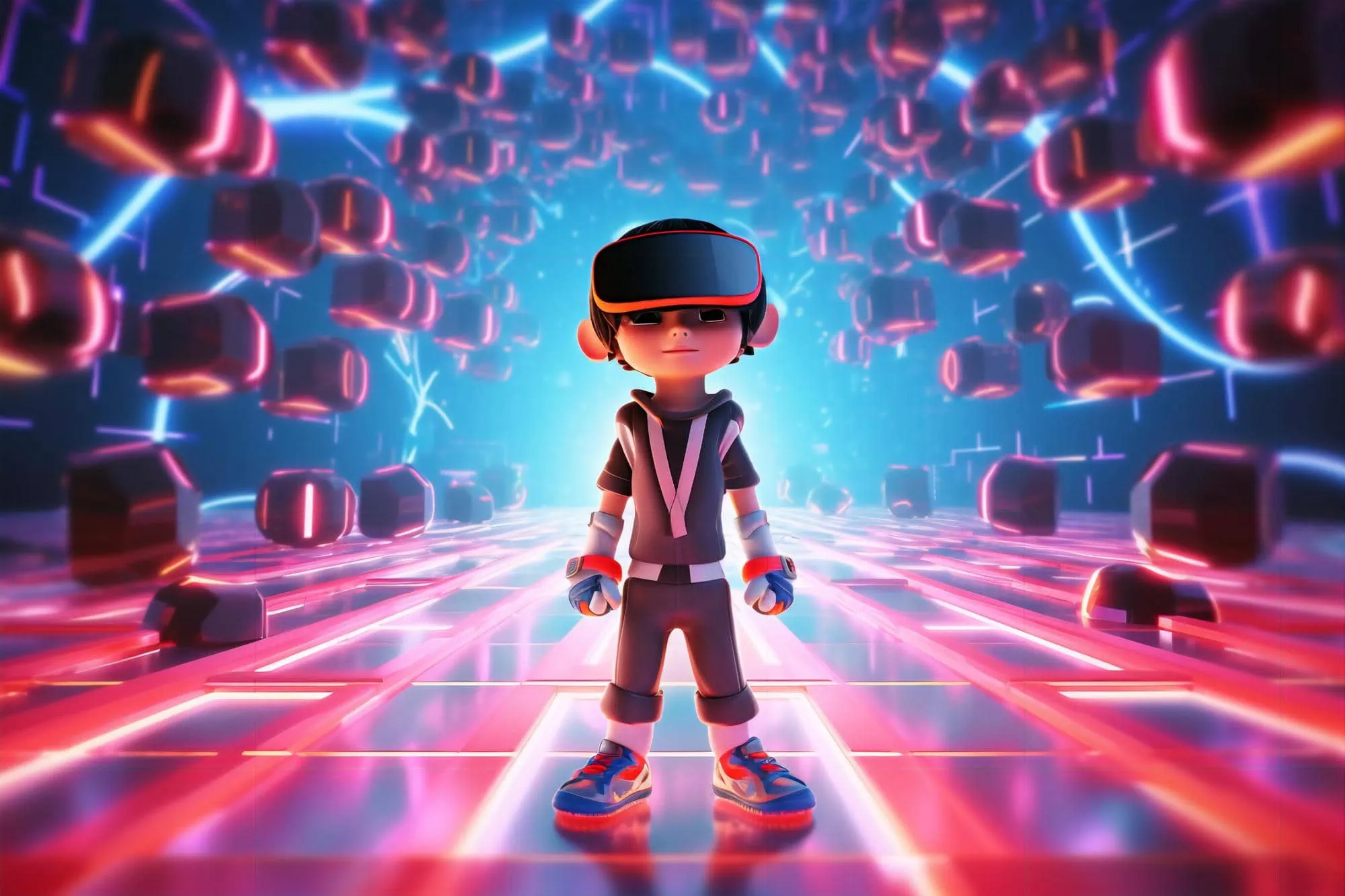
As we stand on the precipice of a new digital age, the metaverse emerges as the most exciting frontier in design and technology.
It promises a revolution in how we interact with digital spaces and how we perceive reality itself.
The Exciting Frontier of Metaverse Designing
The metaverse is not just another digital platform; it’s a paradigm shift. It weaves together the threads of virtual reality, augmented reality, and digital interactivity into a tapestry of endless possibilities.
For graphic designers, this presents a challenge like no other, demanding creativity, technological prowess, and a deep understanding of human behavior.
Yet, the rewards are unparalleled. In the metaverse, designers have the power to shape worlds, craft narratives, and redefine the very essence of experience.
But the significance of the metaverse goes beyond design. It can change how we learn, work, socialize, and entertain ourselves.
It can bridge gaps, fostering global communities that transcend geographical boundaries. It can be an educational tool, a business platform, a social space, and an artistic canvas all rolled into one.
Call-to-Action for Designers to Lead the Way and Shape the Future
The metaverse is still in its nascent stages, and its future is yet unwritten. This is a clarion call for designers everywhere: to lead the charge, shape this burgeoning realm, and define its ethos.
As stewards of this new frontier, designers have a responsibility. They must ensure that the metaverse is inclusive, ethical, and user-centric.
They have the power to set the standards, establish the best practices, and lay the foundations for what’s to come.
Hence, to every designer reading this: the metaverse is your canvas, vast and uncharted.
It’s time to dream big, innovate, collaborate, and create.
The future of the digital realm is in your hands, waiting to be shaped, molded, and brought to life.
Step forward, embrace the challenge, and let’s together chart the course of the metaverse, one design at a time.
The Metaverse Designing: FAQ
The metaverse designing goes beyond the two-dimensional planes typical of traditional graphic design.
It encompasses creating immersive, three-dimensional virtual spaces where users can interact in real-time. This shift demands designers to consider spatial relationships, user interactivity, real-time reactions, and even multi-sensory experiences.
While foundational design principles still apply, the metaverse introduces complexities such as ensuring a continuous sense of presence, managing user agency, and crafting multi-user interactive scenarios.
In the metaverse, graphic design trends are pivotal in dictating how users perceive, navigate, and interact with the virtual environment.
The fusion of hyper-realistic textures, fluid interfaces, and dynamic lighting can elevate the sense of realism. However, striking the balance between aesthetics and functionality is vital.
For instance, while a visually stunning environment can draw users in, if it’s challenging to navigate or interact with, it can detract from the overall user experience.
The metaverse poses unique challenges:
- Designers must consider scalability and performance across various devices, as not all users will access the metaverse with high-end equipment.
- The metaverse requires designing for a multi-sensory, 3D experience, which can be a significant shift for those accustomed to 2D platforms. Ethical considerations, like combating misinformation or ensuring user safety in shared spaces, also come into play.
- By integrating real-world and digital artifacts, designers must seamlessly blend physical and virtual elements.
The metaverse is rapidly evolving, with it, the realm of graphic design. The future is anticipated to see a more profound convergence of augmented reality (AR) and virtual reality (VR), leading to more blended experiences.
Designs will likely become more adaptive, anticipating user needs and preferences. With AI and machine learning advancements, we might see environments that shape-shift based on user mood or behavior.
Moreover, as the line between user and creator blurs, tools allowing users to customize or co-design their spaces and avatars will become more sophisticated.
The metaverse designing is not just a fleeting trend; it represents the next significant evolution in how we interact digitally.
As businesses, entertainment, and social interactions migrate or expand into these spaces, designers equipped with the knowledge and skills to craft these experiences will be in high demand.
Being proactive now means staying ahead of the curve, leading innovations, and shaping the digital futures we’re all soon to inhabit.
